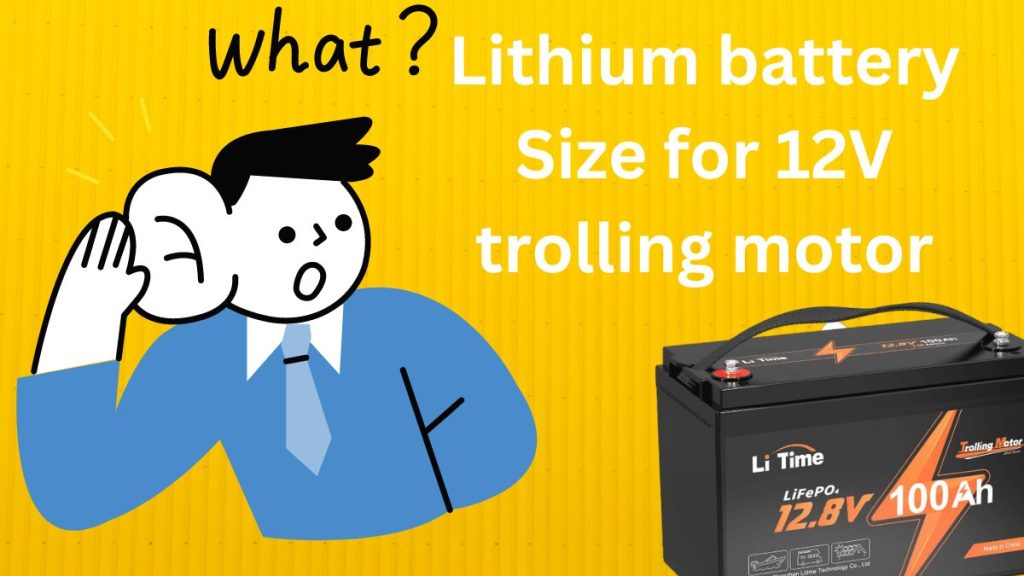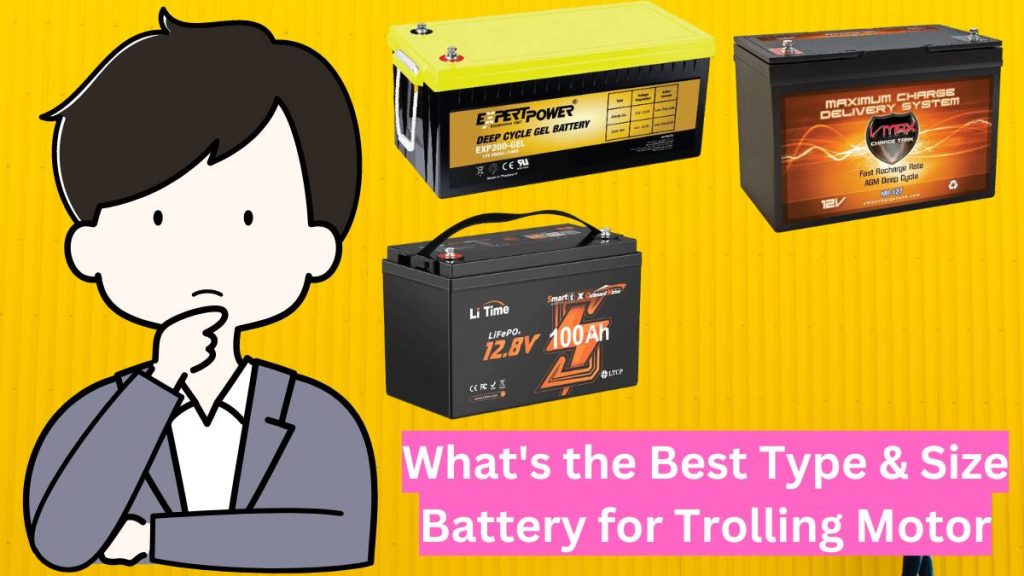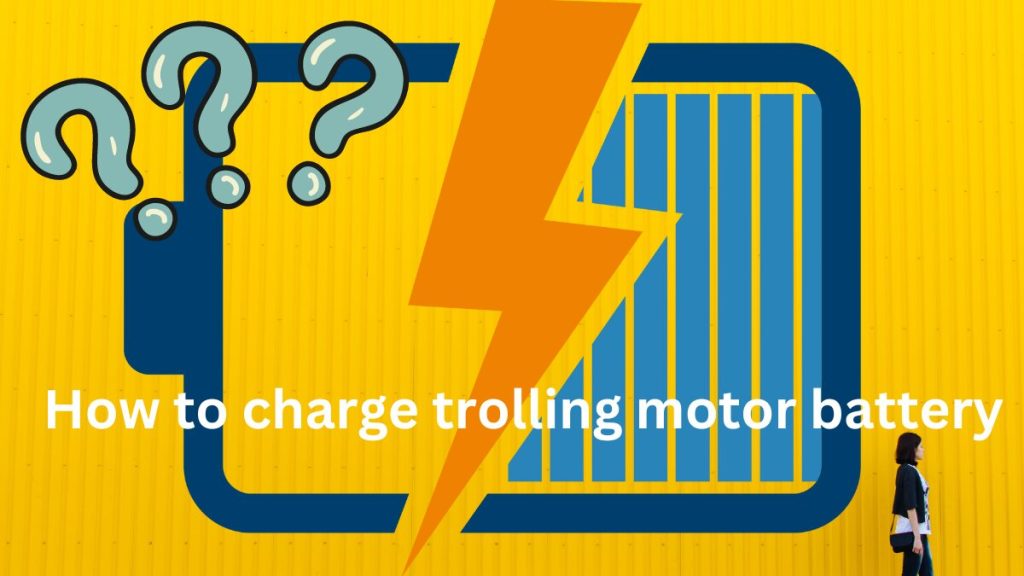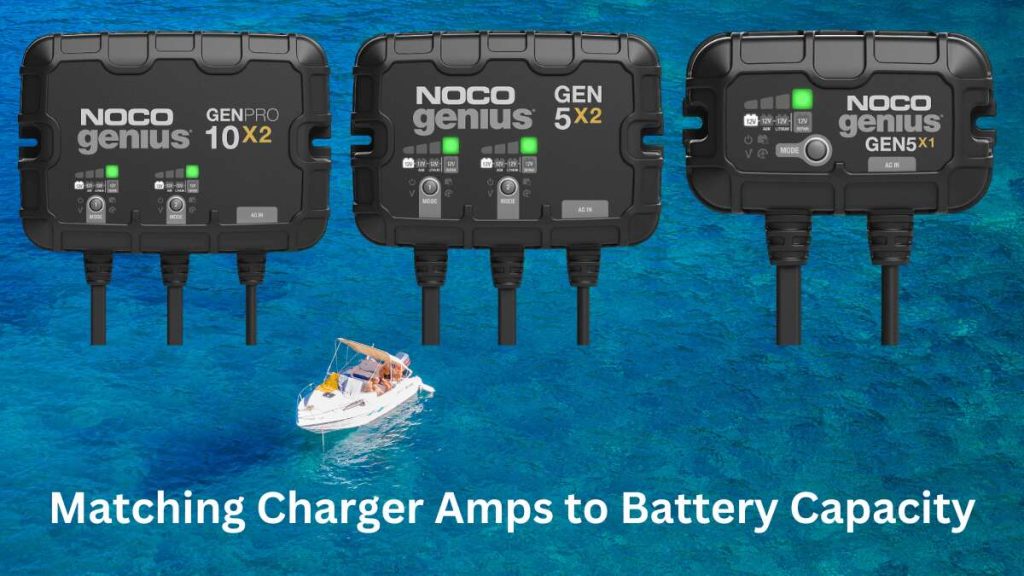Choosing the right battery for your trolling motor can be a bit overwhelming, especially with so many options available. When it comes to powering a 12V trolling motor, one of the most efficient choices is a lithium battery. But, what size lithium battery for 12V trolling motor should you choose? This decision plays a crucial role in determining how long your motor will run, how much weight you’ll carry, and how efficient your overall boating experience will be. Lithium batteries are known for their lightweight design, longer lifespan, and superior energy efficiency compared to traditional lead-acid batteries. They offer an excellent power-to-weight ratio, making them a favorite among anglers and boating enthusiasts.
However, finding the ideal battery size depends on several factors, including your motor’s power requirements, the duration of your trips, and the conditions you typically navigate. In this guide, we’ll dive deep into the specifics of selecting the right size lithium battery for a 12V trolling motor. Whether you’re an avid fisherman who spends hours on the water or someone who enjoys casual boating, understanding these considerations will help you maximize performance and extend the life of your motor.
What is Trolling motor?
A trolling motor is a small, self-contained electric motor designed to propel boats quietly and efficiently, often used by anglers and small boat enthusiasts. It typically consists of an electric motor, propeller, and controls mounted at the bow or stern of the boat. Unlike the main engine, which is used for long-distance travel and higher speeds, a trolling motor is used for slow and controlled movement, especially in shallow waters or when precision is needed.
Purpose of Trolling Motor
The main purpose of a trolling motor is to help maneuver the boat quietly without disturbing fish, making it ideal for fishing. It allows for better control of the boat’s speed and direction, ensuring a smoother, quieter approach to fishing spots. Trolling motors are also commonly used in activities like wildlife observation or any other scenario where a stealthy, smooth boat ride is required. With modern features such as GPS integration, foot-pedal control, and wireless remote operation, trolling motors provide users with convenience and efficiency in navigation.
Types of Trolling Motor Batteries – What size lithium battery for 12V trolling motor
When choosing a battery for your trolling motor, the three main options are lead-acid wet batteries, AGM (Absorbed Glass Mat) batteries, and lithium batteries. Each type has its own set of advantages and disadvantages, making it important to select the right one based on your specific boating needs. Understanding the benefits and limitations of each type can help you make an informed decision.
Lead-Acid Wet Batteries
Lead-acid wet batteries are the most traditional and commonly used type of battery for trolling motors. These batteries are flooded with a liquid electrolyte and have been in use for decades, primarily due to their affordability and widespread availability. They are typically large and heavy but provide sufficient power for short-term boating trips or casual anglers.
Advantages of Lead Acid Wet Batteries:
Lead-acid wet batteries are an economical choice for those who do not require long battery life or frequent use. Their main advantage lies in their affordability, as they are the least expensive of the three main battery types. Additionally, these batteries are widely available, making it easy to replace or upgrade them when needed. They are suitable for low-power trolling motors and short trips, providing a practical solution for boaters on a budget.
Disadvantages of Lead Acid Wet Batteries:
Despite their affordability, lead-acid wet batteries come with a few significant drawbacks. They are the heaviest of all battery types, which can add extra weight to your boat, affecting its performance. These batteries also require regular maintenance, such as checking and refilling the electrolyte levels, which can be inconvenient. Additionally, lead-acid wet batteries have a shorter lifespan compared to AGM and lithium batteries, making them less cost-effective in the long run. Their performance also tends to decline over time, resulting in shorter run times as the battery ages.
AGM Batteries
AGM (Absorbed Glass Mat) batteries are a step up from traditional lead-acid wet batteries. They use a glass mat to hold the electrolyte, making them maintenance-free and more efficient. AGM batteries are sealed, meaning they don’t require the same upkeep as lead-acid wet batteries, and they perform better in extreme conditions, such as hot or cold weather.
Advantages of AGM Batteries:
AGM batteries offer several advantages, making them a popular choice for trolling motor users. They are maintenance-free, meaning you don’t have to worry about checking water levels or adding electrolyte. They are also more durable and resistant to vibration, which is crucial in rough boating conditions. AGM batteries can hold a charge longer than lead-acid batteries, providing more power for extended periods on the water. They are also safer, as they are sealed and prevent spillage of the electrolyte.
Disadvantages of AGM Batteries:
One major disadvantage of AGM batteries is their cost. They are more expensive than traditional lead-acid wet batteries, making them a larger upfront investment. Additionally, while they last longer than lead-acid batteries, their lifespan is still shorter than lithium batteries. AGM batteries are also heavier than lithium batteries, though they are lighter than lead-acid wet batteries. For those looking to minimize boat weight and maximize efficiency, this added weight can be a drawback.
Lithium Batteries
Lithium batteries represent the most advanced technology available for trolling motor applications. They are lightweight, long-lasting, and require little to no maintenance, making them the best option for frequent boaters or those looking to maximize efficiency. If you’re wondering what size lithium battery for a 12V trolling motor, the answer depends on factors like your motor’s power requirements and how long you intend to stay on the water. However, lithium batteries generally offer more power and longer run times compared to other options.
Advantages of Lithium Batteries:
Lithium batteries have several distinct advantages. Their lightweight design is perhaps the most appealing feature, significantly reducing the overall weight of your boat and improving performance. They also have a much longer lifespan than both lead-acid and AGM batteries, making them a cost-effective solution in the long run despite their higher initial cost. Lithium batteries are highly efficient, maintaining consistent power output even as the charge depletes. Additionally, they require no maintenance and can withstand a wide range of temperatures, making them ideal for various boating conditions. With quick charging times, lithium batteries are also more convenient for users who need to recharge frequently.
Disadvantages of Lithium Batteries:
The primary disadvantage of lithium batteries is their high upfront cost. While they do offer long-term savings due to their extended lifespan, the initial investment can be significant for many boaters. Additionally, not all lithium batteries are compatible with every trolling motor, so it’s important to ensure that the specific model you choose works with your setup. Some users may also find that lithium batteries have a slightly different charging and discharging behavior compared to other battery types, which may require getting used to. Despite these challenges, lithium batteries are often considered the best choice for serious anglers and boaters who prioritize performance and reliability.
Factors to Consider When Choosing a Trolling Motor Battery
Selecting the right battery for your trolling motor is crucial to ensure you get the best performance, efficiency, and longevity for your boat. The battery you choose directly impacts the motor’s run time, power, and reliability. Here are several important factors to consider when choosing a trolling motor battery:
1. Battery Type
The type of battery you select will determine the motor’s overall performance and how often you’ll need to replace it. There are three primary types of trolling motor batteries: lead-acid wet batteries, AGM (Absorbed Glass Mat) batteries, and lithium batteries. Each has its advantages and disadvantages:
- Lead-Acid Wet Batteries are the most affordable option but require regular maintenance and have a shorter lifespan.
- AGM Batteries are more efficient and maintenance-free but come at a higher cost.
- Lithium Batteries are lightweight, long-lasting, and maintenance-free, offering the best performance but with a high upfront cost. If you’re wondering what size lithium battery for a 12V trolling motor, it will largely depend on your motor’s power needs and how long you need it to run on a single charge.
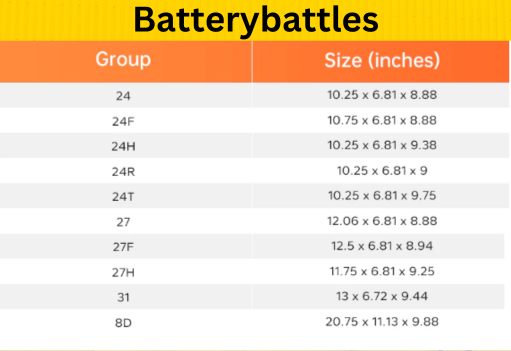
2. Battery Voltage
Most trolling motors are designed to run on 12V, 24V, or 36V systems. The higher the voltage, the more power the battery will provide, and the longer the motor will run. If you have a 12V trolling motor, you’ll need a 12V battery. For longer run times and more powerful motors, you may want to consider a 24V or 36V system, which requires multiple batteries wired in series.
3. Amp-Hour Rating (Ah)
The amp-hour rating indicates how much capacity a battery has and how long it will last before needing to be recharged. A higher amp-hour rating means a longer run time for your trolling motor. If you plan on spending long hours on the water, a higher amp-hour battery is recommended. For example, a 100Ah battery will last longer than a 50Ah battery under the same conditions. For a 12V trolling motor, a lithium battery with a higher Ah rating will give you extended run time compared to a lead-acid battery with the same rating.
4. Battery Weight
The weight of the battery can significantly impact your boat’s performance, especially if you’re running a small vessel or kayak. Lead-acid wet batteries are the heaviest, while AGM batteries are slightly lighter. Lithium batteries, on the other hand, are the lightest option, often weighing 50% to 60% less than their lead-acid counterparts. A lighter battery will reduce the overall weight of your boat, improving speed, fuel efficiency, and handling.
5. Lifespan and Durability
The lifespan of a battery refers to how many charge cycles it can handle before its performance starts to decline. Lead-acid wet batteries have the shortest lifespan, typically lasting around 300-500 cycles. AGM batteries offer more durability with a lifespan of 500-800 cycles, and lithium batteries last the longest, with a lifespan of 2,000 or more cycles. Although lithium batteries are more expensive initially, their long lifespan makes them a better investment for those who use their trolling motor frequently.
6. Charging Time
Charging time is another important consideration, especially if you plan on using your trolling motor for extended periods. Lead-acid wet batteries and AGM batteries can take several hours to fully charge, whereas lithium batteries charge much faster. This is particularly useful if you need to get back on the water quickly. However, make sure to use a charger that’s compatible with your battery type to prevent damage and ensure optimal performance.
7. Maintenance Requirements
Battery maintenance is a factor that can affect convenience and overall performance. Lead-acid wet batteries require regular maintenance, such as checking electrolyte levels and adding water to prevent damage. AGM and lithium batteries, on the other hand, are maintenance-free. If you prefer a hassle-free option, AGM or lithium batteries are better suited to your needs.
8. Cost
Cost is often a deciding factor when choosing a trolling motor battery. Lead-acid wet batteries are the cheapest option upfront, but they have a shorter lifespan and require more maintenance. AGM batteries are a bit more expensive but offer better performance and durability. Lithium batteries are the most expensive initially, but their extended lifespan, lightweight design, and low maintenance requirements make them the most cost-effective solution in the long run.
9. Compatibility with Your Trolling Motor
Not all batteries are compatible with every trolling motor, so it’s essential to check the manufacturer’s recommendations. Some motors may require a specific battery type or voltage. For instance, if you have a 12V trolling motor, you’ll need to select a 12V battery that meets the motor’s power requirements. When choosing what size lithium battery for a 12V trolling motor, consider factors such as motor power, how long you plan to be on the water, and the conditions in which you’ll be using your boat.
10. Environmental Impact
If environmental impact is important to you, it’s worth noting that lithium batteries are more eco-friendly compared to lead-acid batteries. They have a longer lifespan, reducing the number of batteries you’ll need to dispose of over time. Additionally, lithium batteries are made using more sustainable materials, while lead-acid batteries can pose environmental risks if not properly recycled.
11. Discharge Rate
Different batteries discharge power at different rates, which can affect your trolling motor’s performance. Lead-acid batteries tend to lose power more quickly as they discharge, while AGM and lithium batteries maintain a more consistent output. Lithium batteries are particularly known for their ability to provide consistent power output until they are nearly depleted, making them ideal for long trips where steady performance is crucial.
Choosing the right trolling motor battery requires careful consideration of several factors, including battery type, voltage, amp-hour rating, weight, lifespan, and cost. While lead-acid wet batteries are an affordable option, they may not offer the best long-term performance. AGM batteries provide a good balance of cost and efficiency, while lithium batteries, although more expensive upfront, offer superior performance, longevity, and environmental benefits. Ultimately, the best battery for your trolling motor will depend on how you use your boat, how long you plan to stay on the water, and how much you’re willing to invest in performance and reliability. For those looking to maximize their trolling motor’s efficiency, understanding what size lithium battery for a 12V trolling motor is essential to ensure optimal performance.
What Size Battery is Suitable for Trolling?
Selecting the right battery size for your trolling motor is crucial for optimizing performance and ensuring your boat has sufficient power for extended use. The size of the battery depends on several factors, such as the type of trolling motor, how long you intend to be on the water, and the conditions under which you’ll be operating. Here’s a detailed guide to help you understand what size battery is suitable for your trolling needs.
Factors That Determine Battery Size
Amp Hours (Ah) Rating:
The amp-hour (Ah) rating is the primary measure used to determine how long a battery can supply power to your trolling motor. The higher the Ah rating, the longer the battery will last during operation. For example, a battery with a 100 Ah rating can theoretically provide 100 amps of power for one hour or 10 amps of power for 10 hours. To decide what size battery you need, consider how long you’ll be on the water and how much power your trolling motor draws. If your motor consumes 20 amps per hour and you plan to be out for 5 hours, you’ll need at least a 100 Ah battery.
Voltage:
Trolling motors come in different voltage configurations, typically 12V, 24V, or 36V. A 12V motor requires one 12V battery, while a 24V motor requires two 12V batteries connected in series, and a 36V motor needs three 12V batteries. For a 12V trolling motor, choosing the right battery size depends largely on the motor’s power draw and the battery’s Ah rating.
Motor Thrust:
Trolling motor thrust is a measure of the motor’s power and is usually expressed in pounds (lbs). Motors with higher thrust ratings require more power to operate. For example, a 30 lb thrust trolling motor will draw less power than a 70 lb thrust motor. As a rule of thumb, for every 100 pounds of boat weight, you’ll need around 2 lbs of thrust. The larger the motor, the larger the battery you’ll need to ensure it runs efficiently.
Boating Conditions:
The size of the battery also depends on the conditions in which you typically operate. If you are fishing in calm, freshwater lakes, your motor won’t need as much power, and a smaller battery may suffice. However, if you are navigating strong currents, saltwater environments, or rough waters, your motor will need more power to maneuver, requiring a larger battery with a higher Ah rating.
Fishing Duration and Frequency:
The length of your trips and how often you go fishing play a big role in determining the right battery size. For short trips or casual use, a smaller battery with a lower Ah rating may be adequate. But if you spend long hours on the water or fish frequently, a higher-capacity battery is essential to ensure you don’t run out of power in the middle of a trip.
Battery Type:
The type of battery you choose—whether it’s a lead-acid wet battery, AGM battery, or lithium battery—also influences the size. Lithium batteries, for example, offer higher energy density, meaning you can get more power from a smaller-sized battery compared to lead-acid or AGM options. For those wondering what size lithium battery for a 12V trolling motor, a lithium battery with an Ah rating of 50 to 100 is typically ideal for most 12V setups, providing more extended run time and better efficiency than traditional batteries.
| Voltage of Motor | Motor Thrust | Recommended Max Amp of Batteries | Recommended LiFePO4 Batteries | Why / Reasons |
|---|---|---|---|---|
| 12V | 20 ~ 30 lb | 50A | LiTime 12V 50Ah Lithium Battery | Cost-effective |
| 12V | 30 ~ 70 lb | 100A | LiTime 12V 100Ah Lithium Battery | Cost-effective, Low-temp, Lighter |
| 24V | 70 ~ 100 lb | 100A | Redodo 24V 100Ah Lithium Battery | Cost-effective |
| 36V | 100 ~ 120 lb | 100A | LiTime 36V 55Ah Marine Trolling Motor Lithium Battery | One single battery is enough |
Recommended Battery Sizes for Different Trolling Motors
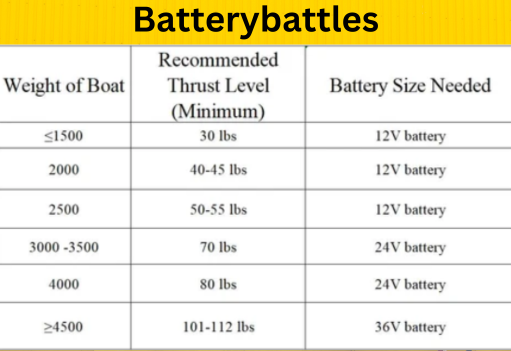
12V Trolling Motors:
For most 12V trolling motors, a battery with an Ah rating of 50 to 100 is ideal. If you’re planning short fishing trips or only use your motor occasionally, a 50 Ah battery might be enough. However, for more extended trips or heavy-duty use, a 100 Ah battery will ensure you have enough power to last all day.
24V Trolling Motors:
24V motors require two 12V batteries connected in series. In this case, each battery should have an Ah rating of at least 50 to 100, depending on your usage. This setup provides double the voltage of a single 12V battery, allowing for more power and longer run times, which is especially useful for larger boats or more challenging conditions.
36V Trolling Motors:
A 36V trolling motor requires three 12V batteries connected in series. Each battery should have an Ah rating of at least 75 to 100. This setup is recommended for larger boats or for boaters who need maximum power and run time, such as those who fish in saltwater or strong currents.
Battery Size Based on Boat Size and Weight
The size of your boat and the total weight it carries also influence the size of the battery you’ll need. Heavier boats with more gear or passengers require more thrust from the trolling motor, which in turn requires a larger battery. As a general guideline, for every 100 pounds of weight, you’ll need about 2 lbs of thrust. If you’re using a 12V motor with 30 lbs of thrust for a small boat, a 50 Ah battery may be sufficient. For larger boats or more powerful motors, you’ll need a higher capacity battery to ensure optimal performance.
The size of the battery that is suitable for trolling depends on several factors, including the trolling motor’s voltage, the amp-hour rating, the thrust of the motor, and the type of conditions you’ll be facing. For most users, a 12V trolling motor paired with a 50 to 100 Ah battery will offer sufficient power for a full day on the water. If you’re using a 24V or 36V motor, you’ll need multiple batteries with higher Ah ratings to ensure long-lasting performance. If you’re looking for efficiency, performance, and longer run times, lithium batteries are an excellent option. For those asking what size lithium battery for a 12V trolling motor, a 50 to 100 Ah lithium battery is a perfect choice for maximizing power and reducing weight on your boat.
How Does a Battery Size Affect a Boat’s Performance?
The size of the battery used in a trolling motor plays a crucial role in determining a boat’s overall performance. It affects everything from the duration of your trips to the boat’s speed, power, and maneuverability. Selecting the right battery size ensures you can make the most of your time on the water, while a poorly chosen battery can limit your activities and reduce efficiency. Here’s how battery size impacts different aspects of a boat’s performance:
1. Run Time and Duration on the Water
One of the most significant ways battery size influences performance is through the amount of time you can spend on the water. A larger battery with a higher amp-hour (Ah) rating provides more energy, allowing your trolling motor to run for a longer period. For instance, if you choose a battery with a low Ah rating, you may only get a few hours of use before it needs recharging. However, with a higher capacity battery, you can enjoy full-day trips without worrying about losing power midway through. A larger battery ensures you won’t have to cut your trip short due to power limitations.
2. Power and Speed
The size of the battery also affects the power output of your trolling motor, directly influencing the speed and thrust of your boat. A larger battery with sufficient capacity ensures the motor runs at optimal power, providing higher speeds and better control over the boat’s movement. Smaller batteries may struggle to maintain a consistent power output, resulting in reduced speeds, especially when operating under challenging conditions like strong currents or windy environments. For larger boats or those needing more power for maneuvering, a bigger battery is essential to maintain peak performance.
3. Motor Efficiency
The battery size you choose can affect how efficiently your trolling motor operates. When paired with an undersized battery, the motor may draw more power than the battery can supply, which can strain both the battery and the motor. This can lead to reduced battery life and decreased overall performance. A properly sized battery ensures your motor can operate at its full potential without causing undue wear or inefficiency. For example, in the case of a 12V trolling motor, selecting the right battery size ensures you get the best balance between power and efficiency. Lithium batteries, in particular, offer superior efficiency compared to traditional lead-acid batteries, delivering more power for longer periods.
4. Weight and Balance
Larger batteries tend to weigh more, which can impact your boat’s weight distribution and balance. For small boats, an excessively heavy battery can cause the boat to sit lower in the water, reducing maneuverability and increasing drag. This can make it harder to navigate shallow waters or maintain speed. On the other hand, lithium batteries, despite offering high capacity, are much lighter compared to traditional lead-acid or AGM batteries. This reduced weight can enhance the boat’s performance by improving speed and fuel efficiency, as there’s less drag on the water. Balancing battery size and weight is key to achieving optimal boat handling and performance.
5. Battery Longevity and Performance Consistency
A larger battery with a higher Ah rating will generally last longer and provide more consistent performance over time compared to a smaller one. Smaller batteries tend to drain faster, and as they deplete, the motor’s performance can decline, resulting in slower speeds and reduced thrust. A larger battery ensures that your trolling motor can maintain consistent power throughout the trip, providing better control and a more enjoyable boating experience. Additionally, larger batteries tend to have a longer lifespan, meaning you’ll replace them less frequently, leading to long-term savings.
The size of the battery has a direct and significant impact on a boat’s performance. A larger battery provides extended run time, more consistent power, and better efficiency, all while supporting the boat’s speed and handling. However, it’s essential to balance battery size with the boat’s overall weight capacity and power requirements. By selecting the right battery size, you can ensure that your trolling motor operates smoothly, efficiently, and reliably, giving you the best possible experience on the water.
Factors to Consider When Choosing the Right Battery Size
Choosing the correct battery size for your trolling motor is essential to ensure optimal performance, efficiency, and longevity on the water. Several factors play a role in determining the appropriate battery size, including your boat’s size and weight, the motor’s thrust requirements, and the fishing conditions you typically encounter. Here’s a breakdown of the key considerations:
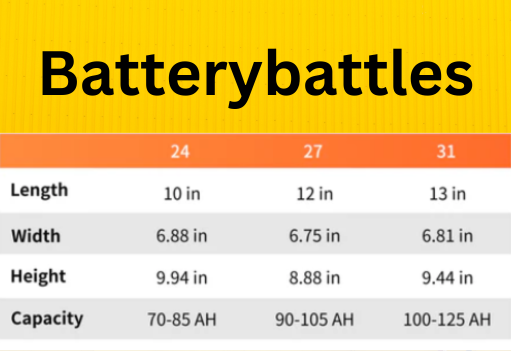
1. Boat Size and Weight
The size and weight of your boat are significant factors in determining the right battery size for your trolling motor. Larger and heavier boats require more power to move and maneuver effectively. The more weight the boat carries, including passengers, gear, and equipment, the more energy your trolling motor will need to operate. As a result, boats with heavier loads will require a battery with a higher amp-hour (Ah) rating to ensure sufficient run time and power output.
For smaller boats with minimal weight, a smaller battery with a lower Ah rating may suffice. However, for larger boats, such as bass boats or pontoons, a larger battery with a high Ah rating (typically 100 Ah or more) is necessary to provide the necessary power and maintain optimal performance throughout your trip. Ensuring the battery can handle the weight and size of your boat is critical for smooth operation and to prevent overworking the motor.
2. Trolling Motor Thrust
Trolling motor thrust is a measure of how much power the motor can generate to move the boat through the water. It’s typically measured in pounds (lbs), and the right amount of thrust depends on the boat’s weight and size. The general rule of thumb is that for every 100 pounds of boat weight, you need at least 2 lbs of thrust. Therefore, the more thrust your motor requires, the more power your battery will need to supply, which in turn affects the size of the battery.
For example, a small 30-lb thrust trolling motor may be adequately powered by a smaller battery, while a larger motor with 70 lbs or more of thrust will require a higher-capacity battery to maintain speed and efficiency. If the battery is too small, it may struggle to provide sufficient power, leading to shorter run times, reduced performance, and potential damage to both the battery and motor.
3. Fishing Conditions
The conditions in which you plan to fish play a crucial role in determining the appropriate battery size for your trolling motor. If you frequently fish in calm freshwater lakes, where the motor doesn’t have to work hard to overcome strong currents or winds, a smaller battery with a moderate Ah rating might be sufficient. However, if you fish in rougher waters, strong currents, or windy conditions, your trolling motor will need more power to navigate these challenges effectively. In such cases, a larger battery with a higher Ah rating is necessary to ensure the motor has enough energy to operate smoothly.
Additionally, if you fish in saltwater, which tends to be more demanding on equipment, a higher-capacity battery is essential. Saltwater environments can be harsher, requiring more power to maintain boat control and avoid motor strain. Therefore, it’s essential to choose a battery that can handle the specific conditions of your fishing environment to ensure a successful and uninterrupted experience on the water.
Advantages and Disadvantages of Using Larger or Smaller Batteries for Trolling Motors
Choosing the right battery size for your trolling motor can significantly impact performance, efficiency, and convenience. Larger batteries and smaller batteries each come with their own sets of advantages and disadvantages, depending on your boating needs. Here’s a closer look at the benefits and drawbacks of both larger and smaller batteries, including how to determine what size lithium battery for a 12V trolling motor you should select.
Advantages of Using Larger Batteries
1. Longer Run Time:
One of the biggest advantages of using a larger battery is extended run time. Larger batteries have higher amp-hour (Ah) ratings, meaning they can store more energy and last longer during trips. This is particularly useful for those who spend long hours on the water, such as anglers or boaters who need the motor to run for extended periods.
2. Increased Power Output:
Larger batteries typically provide more power, which can be essential for running more powerful trolling motors or navigating against strong currents. If you’re using a motor with higher thrust requirements, a larger battery ensures that it can deliver the necessary power without running out of energy quickly.
3. Fewer Recharges:
With a larger battery, you won’t need to recharge as frequently, which is a major convenience for those who want to spend more time on the water and less time worrying about their battery levels. This is especially beneficial during multi-day trips where charging facilities might not be available.
4. Better for Heavy Loads:
If you have a larger or heavier boat, a larger battery will be able to handle the increased load without significantly affecting performance. This is important for maintaining the boat’s speed and maneuverability in different water conditions.
Disadvantages of Using Larger Batteries
1. Increased Weight:
Larger batteries are heavier, which can add significant weight to your boat. This added weight can affect the overall performance of your boat, slowing it down and making it harder to maneuver. For smaller boats, the extra weight can be especially problematic, impacting balance and fuel efficiency.
2. More Expensive:
Larger batteries tend to be more expensive due to their higher capacity and extended run time. While this may be worth the investment for frequent boaters, it can be cost-prohibitive for those who only use their trolling motor occasionally or for short trips.
3. More Space Required:
Larger batteries take up more space, which can be a problem in boats with limited storage or deck space. If you already have a lot of gear or other equipment on board, a larger battery may not be the most practical option, as it could limit space for other essentials.
4. Overkill for Short Trips:
For boaters who typically take short trips or only need their trolling motor for light use, a larger battery may be more than necessary. The added cost and weight might not provide enough value for users who don’t need the extended run time or extra power output.
Advantages of Using Smaller Batteries
1. Lighter Weight:
Smaller batteries are much lighter, which reduces the overall weight of the boat. This can improve the boat’s performance, making it faster and easier to maneuver, especially in calm waters. The reduced weight is also beneficial for smaller boats, where every pound counts in maintaining balance and stability.
2. More Affordable:
Smaller batteries are generally more affordable, making them a budget-friendly option for those who don’t need extended run times or higher power outputs. If you only go on short trips or don’t rely heavily on your trolling motor, a smaller battery can save you money without sacrificing performance.
3. Easier to Install and Handle:
Smaller batteries are easier to install, remove, and transport due to their lighter weight and compact size. This makes them a convenient choice for boaters who prefer quick and easy setup, or for those who frequently move the battery between different boats or charging locations.
4. Saves Space:
A smaller battery takes up less room on the boat, leaving more space for gear, supplies, or additional equipment. If you’re working with a limited deck or storage area, a smaller battery may be a better option, allowing you to optimize your space efficiently.
Disadvantages of Using Smaller Batteries
1. Shorter Run Time:
One of the most significant disadvantages of a smaller battery is the reduced run time. With lower amp-hour ratings, smaller batteries won’t last as long on the water, requiring more frequent recharges. For users who spend long hours boating or fishing, this can be a major inconvenience, especially if recharging options are limited.
2. Lower Power Output:
Smaller batteries offer less power, which can limit the performance of your trolling motor. If you’re using a high-thrust motor or navigating strong currents, a smaller battery might not provide enough power to keep the boat moving efficiently. This could lead to slower speeds or even the motor cutting out prematurely.
3. More Frequent Recharging:
With smaller batteries, you’ll need to recharge more often. This can be time-consuming, especially during longer trips or if you don’t have easy access to charging facilities. The constant need for recharging can interrupt your time on the water, making smaller batteries less practical for frequent or extended use.
4. Limited for Heavier Boats:
Smaller batteries may struggle to power larger or heavier boats effectively. If you have a heavier load, the motor may need to work harder, draining the battery faster and reducing run time. In such cases, a smaller battery might not be able to keep up with the demands of your boat, affecting performance and potentially leaving you stranded.
When determining what size lithium battery for a 12V trolling motor or any other type of trolling motor battery, it’s essential to balance your needs based on the type of boating you do, the power requirements of your motor, and the duration of your trips. Larger batteries are ideal for long trips, heavier loads, and more powerful motors, while smaller batteries are better suited for shorter trips, lighter boats, and users seeking affordability and ease of use. Understanding the advantages and disadvantages of both options will help you choose the best battery for your trolling motor and maximize your boating experience.
Is a 12v 20ah lithium good for a troling motor?
A 12V 20Ah lithium battery can be a good choice for a trolling motor, but whether it’s suitable depends on several factors, including the power requirements of your trolling motor, the size of your boat, and how long you plan to be on the water. Here’s a breakdown of its suitability:
Advantages of a 12V 20Ah Lithium Battery
1. Lightweight and Compact:
Lithium batteries, including the 12V 20Ah model, are known for their lightweight and compact design compared to lead-acid batteries. This can help reduce the overall weight of your boat, improving performance and maneuverability.
2. Long Lifespan:
Lithium batteries have a significantly longer lifespan than traditional lead-acid batteries. A 12V 20Ah lithium battery can typically last several thousand charge cycles, which translates to years of reliable use if properly maintained.
3. Efficient Power Delivery:
Lithium batteries offer consistent power output throughout their discharge cycle, meaning you get stable performance from your trolling motor until the battery is nearly depleted. This can be especially useful for maintaining steady speeds and control.
4. Maintenance-Free:
Lithium batteries require little to no maintenance. You don’t need to worry about checking electrolyte levels or dealing with corrosion, making them a convenient option for regular use.
Considerations for a 12V 20Ah Lithium Battery
1. Battery Capacity:
The 20Ah rating indicates the battery’s capacity to store energy. For a trolling motor, a 12V 20Ah battery provides 240 watt-hours of energy. Whether this is sufficient depends on your motor’s power draw and your boating duration. For instance, if your trolling motor draws 20 amps at 12 volts, the 20Ah battery would provide approximately 1 hour of run time at full power.
2. Run Time and Power Requirements:
Consider the power consumption of your trolling motor and how long you plan to use it. If your motor has a high power draw or if you intend to be on the water for extended periods, you might find that a larger capacity battery is more appropriate. For short trips or lighter use, a 12V 20Ah battery could be adequate.
3. Cost:
Lithium batteries are more expensive upfront than lead-acid or AGM batteries. Ensure that the benefits align with your budget and boating needs. While the 12V 20Ah lithium battery provides excellent performance and longevity, the initial investment can be higher compared to other battery types.
In verdict:
A 12V 20Ah lithium battery is generally a good choice for a trolling motor if it matches your power needs and usage patterns. It offers numerous benefits such as light weight, long lifespan, and efficient power delivery. However, it’s crucial to assess your specific trolling motor’s power requirements and your typical usage to determine if this battery size will meet your needs effectively. For extended use or higher power requirements, you might need a larger capacity battery to ensure reliable performance throughout your trips.
Battery Maintenance and Care Tips
Proper maintenance and care are essential for extending the lifespan and performance of your trolling motor battery, whether it’s lead-acid, AGM, or lithium. Here are some key tips to ensure your battery stays in optimal condition:
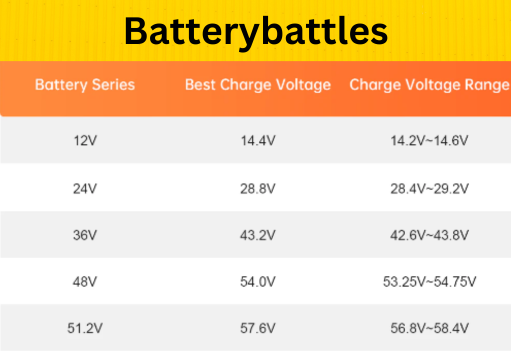
1. Regular Charging
Lead-Acid and AGM Batteries:
- Charge After Use: Always charge your lead-acid or AGM battery after each use. Allowing the battery to fully discharge before recharging can shorten its lifespan.
- Avoid Deep Discharge: Try to keep the battery’s charge above 50% to avoid deep discharges, which can damage the battery and reduce its capacity.
Lithium Batteries:
- Top Off Regularly: Lithium batteries have a built-in battery management system (BMS) that helps protect against overcharging and deep discharge. However, it’s still good practice to recharge the battery before it gets too low.
2. Proper Storage
Lead-Acid and AGM Batteries:
- Store in a Cool, Dry Place: Store these batteries in a cool, dry environment to prevent them from freezing or overheating, both of which can damage the battery.
- Periodic Maintenance: Check the electrolyte levels regularly (for wet batteries) and ensure the battery terminals are clean and free of corrosion.
Lithium Batteries:
- Avoid Extreme Temperatures: Store lithium batteries in moderate temperatures. Extreme cold or heat can negatively affect performance and lifespan.
- Store Fully Charged: For long-term storage, keep the battery fully charged but avoid storing it in a completely charged or empty state for extended periods.
3. Clean Battery Terminals
- Regular Inspection: Periodically inspect battery terminals for corrosion or dirt. Clean the terminals with a mixture of baking soda and water to remove corrosion, followed by a rinse with plain water. Ensure the terminals are completely dry before reconnecting.
- Apply Anti-Corrosion Gel: After cleaning, apply a thin layer of anti-corrosion gel or grease to the terminals to prevent future corrosion.
4. Secure Battery Connections
- Check Tightness: Ensure all battery connections are tight and secure. Loose connections can lead to poor performance and potential damage to the battery or trolling motor.
- Inspect Cables: Regularly inspect the battery cables for signs of wear, fraying, or damage. Replace any damaged cables immediately to prevent electrical issues.
5. Use the Right Charger
- Compatible Charger: Always use a charger that is compatible with your battery type. For lead-acid and AGM batteries, use a charger specifically designed for those battery types. For lithium batteries, ensure you use a charger designed for lithium chemistry to avoid overcharging or damaging the battery.
- Avoid Overcharging: Follow the manufacturer’s recommendations for charging times and voltages to avoid overcharging, which can reduce battery lifespan.
6. Monitor Battery Health
- Check Voltage and Capacity: Regularly monitor the battery’s voltage and capacity. Many lithium batteries come with built-in monitoring systems that provide real-time information. For lead-acid and AGM batteries, use a multimeter to check voltage levels and battery capacity.
- Perform Load Tests: Periodically perform load tests to ensure the battery can deliver adequate power under typical use conditions. This can help identify potential issues before they affect performance.
7. Follow Manufacturer’s Guidelines
- Read the Manual: Always refer to the manufacturer’s guidelines and recommendations for battery maintenance and care. Each type of battery may have specific instructions for optimal performance and longevity.
- Warranty Information: Keep track of warranty information and follow any specific maintenance requirements outlined by the manufacturer to ensure warranty coverage.
By following these maintenance and care tips, you can help ensure that your trolling motor battery remains in excellent condition, providing reliable performance and extending its lifespan. Regular attention to these practices will also enhance your overall boating experience, allowing you to enjoy longer trips and more efficient use of your trolling motor.
Conclusion: What size lithium battery for 12V trolling motor
In conclusion, selecting the right size lithium battery for a 12V trolling motor is crucial for optimizing both performance and efficiency on the water. When determining what size lithium battery for a 12V trolling motor suits your needs, consider factors such as your trolling motor’s power requirements, the duration of your trips, and the weight and space constraints of your boat. A larger battery offers extended run times and higher power outputs, making it ideal for long fishing excursions or navigating challenging waters. However, it comes with added weight and cost. Conversely, a smaller battery provides a lighter and more affordable option, suitable for short trips or lighter power needs, but may require more frequent recharging and offer less power.
Lithium batteries are advantageous for their lightweight design, long lifespan, and maintenance-free operation, making them a superior choice compared to traditional lead-acid or AGM batteries. Ultimately, choosing the appropriate battery size involves balancing your specific boating needs with the battery’s capacity and performance characteristics. By carefully evaluating these factors, you can ensure that you select the best lithium battery for your 12V trolling motor, enhancing your overall boating experience and ensuring reliable, efficient operation on the water.

